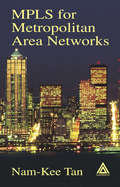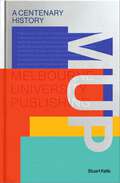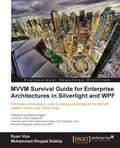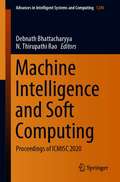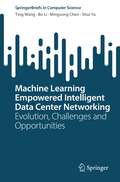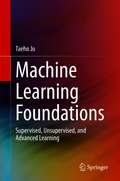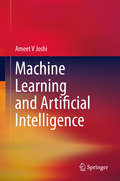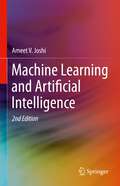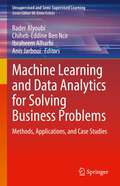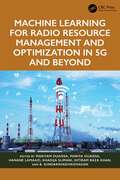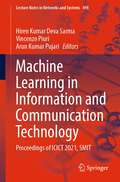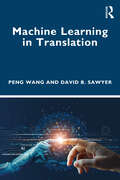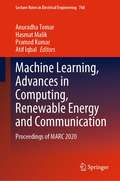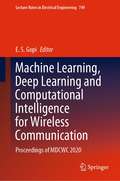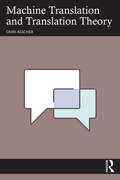- Table View
- List View
MPLS for Metropolitan Area Networks
by Nam-Kee TanMPLS for Metropolitan Area Networks demonstrates solutions provided by MPLS features. The text opens with an overview of metro networks and MPLS. It examines traffic engineering issues, focusing on fundamental TE concepts and network control. The author then discusses how MPLS can bring increased reliability to Metropolitan Area Networks (MANs), and concludes with a detailed analysis of the service aspects of MANs. Topics reviewed include L3 and L2 MPLS VPNs, geographically dispersed Ethernet multipoint services, virtual private LAN services (VPLS), and the integrated services (IntServ) and differentiated services (DiffServ) QoS models with respect to MPLS.
MPLS-Enabled Applications
by Ina Minei Julian LucekWith a foreword by Yakov Rekhter"Here at last is a single, all encompassing resource where the myriad applications sharpen into a comprehensible text that first explains the whys and whats of each application before going on to the technical detail of the hows."--Kireeti Kompella, CTO Junos, Juniper NetworksThe authoritative guide to MPLS, now in its Third edition, fully updated with brand new material!MPLS is now considered the networking technology for carrying all types of network traffic, including voice telephony, real-time video, and data traffic. In MPLS-Enabled Applications, Third Edition, the authors methodically show how MPLS holds the key to network convergence by allowing operators to offer more services over a single physical infrastructure. The Third Edition contains more than 170 illustrations, new chapters, and more coverage, guiding the reader from the basics of the technology, though all its major VPN applications.MPLS Enabled-Applications contains up-to-date coverage of:The current status and future potential of all major MPLS applications, including L2VPN, L3VPN, pseudowires and VPLS.A new chapter with up to date coverage of the MPLS transport profile, MPLS-TP.MPLS in access networks and Seamless MPLS, the new architecture for extending MPLS into the access, discussed in depth for both the unicast and the multicast case.Extensive coverage of multicast support in L3VPNs (mVPNs), explaining and comparing both the PIM/GRE and the next generation BGP/MPLS solutions, and including a new chapter on advanced topics in next generation multicast VPNs.A new chapter on advanced protection techniques, including detailed discussion of 50 ms end-to-end service restoration.Comprehensive coverage of the base technology, as well as the latest IETF drafts, including topics such as pseudowire redundancy, VPLS multihoming, IRB and P2MP pseudowires.MPLS-Enabled Applications will provide those involved in the design and deployment of MPLS systems, as well as those researching the area of MPLS networks, with a thoroughly modern view of how MPLS is transforming the networking world."Essential new material for those trying to understand the next steps in MPLS."--Adrian Farrel, IETF Routing Area Director"MPLS-Enabled Applications takes a unique and creative approach in explaining MPLS concepts and how they are applied in practice to meet the needs of Enterprise and Service Provider networks. I consistently recommend this book to colleagues in the engineering, education and business community."--Dave Cooper, Chief IP Technologist, Global Crossing Ltd
MTEL Magic: Writing Subtest
by Chuck ZuccoThe name of this book is a misnomer. There really is no magical solution to taking this or any other test. What makes this book different is that it presents a simple formula for passing-skills + strategies + practice = success.
MUP: A Centenary History
by Stuart KellsAustralia's oldest university press is also one of our best known and most trusted publishers. Founded in 1921 as a bookshop for students at the University of Melbourne, Melbourne University Press was soon publishing important works that contained the best of national scholarship. Landmark MUP books and series include The Australian Dictionary of Biography, Manning Clark's History of Australia, The Encyclopaedia of New Guinea and the journal Meanjin. These and other MUP publications helped shape how Australians perceived themselves, and how they talked about literature, politics, race, the Pacific, the world wars and public policy. From its inception, MUP grappled with hard questions. How should a university press be governed? To what extent should such a press be concerned with political, polemical and radical works? And can a university press be financially self-sustaining if it focuses on books that commercial publishers overlook? The respective leaders of MUP answered these questions in ways that regularly led the press into controversy. Using a century of MUP publications and archives, Stuart Kells has written a rich and fascinating history of an invaluable Australian institution-one that is widely seen as public property, and whose ups and downs have always been news.
MVVM Survival Guide for Enterprise Architectures in Silverlight and WPF
by Muhammad Shujaat Siddiqi Ryan ViceThis book combines practical, real-world examples with all the background material and theory you need The concepts are explained with a practical LOB enterprise application that is gradually built through the course of this book. MVVM offers lots of design choices and the author shows examples of each of these approaches, by changing the code to achieve the same results. This book will be a valuable resource for Silverlight and WPF developers who want to fully maximize the tools with recommended best practices for enterprise development. This is an advanced book and you will need to be familiar with C#, the .Net framework, and Silverlight or WPF.
Macbeth: The 30-Minute Shakespeare
by Nick NewlinPlanning a school or amateur Shakespeare production? The best way to experience the plays is to perform them, but getting started can be a challenge: The complete plays are too long and complex, while scene selections or simplified language are too limited."The 30-Minute Shakespeare" is a new series of abridgements that tell the "story" of each play from start to finish while keeping the beauty of Shakespeare's language intact. Specific stage directions and character suggestions give even inexperienced actors the tools to perform Shakespeare with confidence, understanding, and fun!This cutting of MACBETH is edited to seven key scenes, opening with the Weird Sisters predicting Macbeth's fate. Also included are Macbeth and his villainous wife plotting to murder King Duncan, the appearance of Banquo's ghost at the banquet, the Witches' unforgettable "double double toil and trouble" scene, and Lady Macbeth's riveting "out, damned spot" sleepwalk. In the finale, the entire cast recites Macbeth's poignant "tomorrow, tomorrow, and tomorrow" speech in unison.The edition also includes an essay by editor Nick Newlin on how to produce a Shakespeare play with novice actors, and notes about the original production of this abridgement at the Folger Shakespeare Library's annual Student Shakespeare Festival.
Machine Intelligence and Soft Computing: Proceedings of ICMISC 2020 (Advances in Intelligent Systems and Computing #1280)
by Debnath Bhattacharyya N. Thirupathi RaoThis book gathers selected papers presented at the International Conference on Machine Intelligence and Soft Computing (ICMISC 2020), held jointly by Vignan’s Institute of Information Technology, Visakhapatnam, India and VFSTR Deemed to be University, Guntur, AP, India during 03-04 September 2020. Topics covered in the book include the artificial neural networks and fuzzy logic, cloud computing, evolutionary algorithms and computation, machine learning, metaheuristics and swarm intelligence, neuro-fuzzy system, soft computing and decision support systems, soft computing applications in actuarial science, soft computing for database deadlock resolution, soft computing methods in engineering, and support vector machine.
Machine Learning Empowered Intelligent Data Center Networking: Evolution, Challenges and Opportunities (SpringerBriefs in Computer Science)
by Mingsong Chen Ting Wang Shui Yu Bo LiAn Introduction to the Machine Learning Empowered Intelligent Data Center Networking Fundamentals of Machine Learning in Data Center Networks. This book reviews the common learning paradigms that are widely used in data centernetworks, and offers an introduction to data collection and data processing in data centers. Additionally, it proposes a multi-dimensional and multi-perspective solution quality assessment system called REBEL-3S. The book offers readers a solid foundation for conducting research in the field of AI-assisted data center networks. Comprehensive Survey of AI-assisted Intelligent Data Center Networks. This book comprehensively investigates the peer-reviewed literature published in recent years. The wide range of machine learning techniques is fully reflected to allow fair comparisons. In addition, the book provides in-depth analysis and enlightening discussions on the effectiveness of AI in DCNs from various perspectives, covering flow prediction, flow classification, load balancing, resource management, energy management, routing optimization, congestion control, fault management, and network security.Provides a Broad Overview with Key Insights. This book introduces several novel intelligent networking concepts pioneered by real-world industries, such as Knowledge Defined Networks, Self-Driving Networks, Intent-driven Networks and Intent-based Networks. Moreover, it shares unique insights into the technological evolution of the fusion of artificial intelligence and data center networks, together with selected challenges and future research opportunities.
Machine Learning Foundations: Supervised, Unsupervised, and Advanced Learning
by Taeho JoThis book provides conceptual understanding of machine learning algorithms though supervised, unsupervised, and advanced learning techniques. The book consists of four parts: foundation, supervised learning, unsupervised learning, and advanced learning. The first part provides the fundamental materials, background, and simple machine learning algorithms, as the preparation for studying machine learning algorithms. The second and the third parts provide understanding of the supervised learning algorithms and the unsupervised learning algorithms as the core parts. The last part provides advanced machine learning algorithms: ensemble learning, semi-supervised learning, temporal learning, and reinforced learning.Provides comprehensive coverage of both learning algorithms: supervised and unsupervised learning;Outlines the computation paradigm for solving classification, regression, and clustering;Features essential techniques for building the a new generation of machine learning.
Machine Learning Modeling for IoUT Networks: Internet of Underwater Things (SpringerBriefs in Computer Science)
by Kaishun Wu Ahmad A. Aziz El-BannaThis book discusses how machine learning and the Internet of Things (IoT) are playing a part in smart control of underwater environments, known as Internet of Underwater Things (IoUT). The authors first present seawater’s key physical variables and go on to discuss opportunistic transmission, localization and positioning, machine learning modeling for underwater communication, and ongoing challenges in the field. In addition, the authors present applications of machine learning techniques for opportunistic communication and underwater localization. They also discuss the current challenges of machine learning modeling of underwater communication from two communication engineering and data science perspectives.
Machine Learning and Artificial Intelligence
by Ameet V JoshiThis book provides comprehensive coverage of combined Artificial Intelligence (AI) and Machine Learning (ML) theory and applications. Rather than looking at the field from only a theoretical or only a practical perspective, this book unifies both perspectives to give holistic understanding. The first part introduces the concepts of AI and ML and their origin and current state. The second and third parts delve into conceptual and theoretic aspects of static and dynamic ML techniques. The forth part describes the practical applications where presented techniques can be applied. The fifth part introduces the user to some of the implementation strategies for solving real life ML problems. The book is appropriate for students in graduate and upper undergraduate courses in addition to researchers and professionals. It makes minimal use of mathematics to make the topics more intuitive and accessible.Presents a full reference to artificial intelligence and machine learning techniques - in theory and application;Provides a guide to AI and ML with minimal use of mathematics to make the topics more intuitive and accessible;Connects all ML and AI techniques to applications and introduces implementations.
Machine Learning and Artificial Intelligence
by Ameet V JoshiThe new edition of this popular professional book on artificial intelligence (ML) and machine learning (ML) has been revised for classroom or training use. The new edition provides comprehensive coverage of combined AI and ML theory and applications. Rather than looking at the field from only a theoretical or only a practical perspective, this book unifies both perspectives to give holistic understanding. The first part introduces the concepts of AI and ML and their origin and current state. The second and third parts delve into conceptual and theoretic aspects of static and dynamic ML techniques. The fourth part describes the practical applications where presented techniques can be applied. The fifth part introduces the user to some of the implementation strategies for solving real life ML problems. Each chapter is accompanied with a set of exercises that will help the reader / student to apply the learnings from the chapter to a real-life problem. Completion of these exercises will help the reader / student to solidify the concepts learned. The book is appropriate for students in graduate and upper undergraduate courses in addition to researchers and professionals. It makes minimal use of mathematics to make the topics more intuitive and accessible. The book covers a large gamut of topics in the area of AI and ML and a professor can tailor a course on AI / ML based on the book by selecting and re-organizing the sequence of chapters to suit the needs.
Machine Learning and Data Analytics for Solving Business Problems: Methods, Applications, and Case Studies (Unsupervised and Semi-Supervised Learning)
by Bader Alyoubi Chiheb-Eddine Ben Ncir Ibraheem Alharbi Anis JarbouiThis book presents advances in business computing and data analytics by discussing recent and innovative machine learning methods that have been designed to support decision-making processes. These methods form the theoretical foundations of intelligent management systems, which allows for companies to understand the market environment, to improve the analysis of customer needs, to propose creative personalization of contents, and to design more effective business strategies, products, and services. This book gives an overview of recent methods – such as blockchain, big data, artificial intelligence, and cloud computing – so readers can rapidly explore them and their applications to solve common business challenges. The book aims to empower readers to leverage and develop creative supervised and unsupervised methods to solve business decision-making problems.
Machine Learning for Critical Internet of Medical Things: Applications and Use Cases
by Fadi Al-Turjman Anand NayyarThis book discusses the applications, challenges, and future trends of machine learning in medical domain, including both basic and advanced topics. The book presents how machine learning is helpful in smooth conduction of administrative processes in hospitals, in treating infectious diseases, and in personalized medical treatments. The authors show how machine learning can also help make fast and more accurate disease diagnoses, easily identify patients, help in new types of therapies or treatments, model small-molecule drugs in pharmaceutical sector, and help with innovations via integrated technologies such as artificial intelligence as well as deep learning. The authors show how machine learning also improves the physician’s and doctor’s medical capabilities to better diagnosis their patients. This book illustrates advanced, innovative techniques, frameworks, concepts, and methodologies of machine learning that will enhance the efficiency and effectiveness of the healthcare system.Provides researchers in machine and deep learning with a conceptual understanding of various methodologies of implementing the technologies in medical areas;Discusses the role machine learning and IoT play into locating different virus and diseases across the globe, such as COVID-19, Ebola, and cervical cancer;Includes fundamentals and advances in machine learning in the medical field, supported by significant case studies and practical applications.
Machine Learning for Mobile Communications (Industry 5.0)
by Chiranji Lal Chowdhary Subrata Chowdhury Sinh Cong Lam Tushar Hrishikesh JawareMachine Learning for Mobile Communications will take readers on a journey from basic to advanced knowledge about mobile communications and machine learning. For learners at the basic level, this book volume discusses a wide range of mobile communications topics from the system level, such as system design and optimization, to the user level, such as power control and resource allocation. The authors also review state-of-the-art machine learning, one of the biggest emerging trends in both academia and industry. For learners at the advanced level, this book discusses solutions for long-term problems with future mobile communications such as resource allocation, security, power control, and spectral efficiency. The book brings together some of the top mobile communications and machine learning experts throughout the world, who contributed their knowledge and experience regarding system design and optimization.This book: Discusses the 5G new radio system design and architecture as specified in 3GPP documents Highlights the challenges including security and privacy, energy, and spectrum efficiency from the perspective of 5G new radio systems Identifies both theoretical and practical problems that can occur in mobile communication systems Covers machine learning techniques such as autoencoder and Q-learning in a comprehensive manner Explores how to apply machine learning techniques to mobile systems to solve modern problems This book is for senior undergraduate and graduate students and academic researchers in the fields of electrical engineering, electronics and communication engineering, and computer engineering.
Machine Learning for Radio Resource Management and Optimization in 5G and Beyond
by Mariya Ouaissa Mariyam Ouaissa B. Sundaravadivazhagan Khadija Slimani Hanane Lamaazi Ihtiram Raza KhanMachine Learning for Radio Resource Management and Optimization in 5G and Beyond highlights a new line of research that uses innovative technologies and methods based on artificial intelligence/machine learning techniques to address issues and challenges related to radio resource management in 5G and 6G communication systems. This book provides comprehensive coverage of current and emerging waveform design, channel modeling, multiple access, random access, scheduling, network slicing, and resource optimization for 5G wireless networks and beyond.This book is suitable for researchers, scholars, and industry professionals working in different fields related to mobile networks and intelligent systems. Additionally, it serves as a hands‑on resource for students interested in the fields of cellular networks (5G/6G) and computational intelligence.
Machine Learning for Wireless Communication (Synthesis Lectures on Communications)
by Rohit M. Thanki Komal R. Borisagar Anjali DiwanThis book covers the basic principles of wireless communication while delving into the fundamentals of machine learning, including supervised and unsupervised learning, deep learning, and reinforcement learning. The authors provide real-world examples and case studies to illustrate the use of machine learning in wireless communication applications such as channel estimation, mobility prediction, resource allocation, and beamforming. This book is an essential resource for researchers, engineers, and students interested in understanding and applying machine learning techniques in the context of wireless communication systems.
Machine Learning in Information and Communication Technology: Proceedings of ICICT 2021, SMIT (Lecture Notes in Networks and Systems #498)
by Vincenzo Piuri Hiren Kumar Deva Sarma Arun Kumar PujariThis book presents collection of research papers presented at International Conference on Information and Communication Technology (ICICT 2021) organized by Department of Information Technology, Sikkim Manipal Institute of Technology, Sikkim, India, during 23–24 December 2021. The book includes papers in the research area of communication networks, data science, healthcare informatics, bio-medical image processing, security of information including cryptography, machine learning applications, and AI applications.
Machine Learning in Translation
by Peng Wang David B. SawyerMachine Learning in Translation introduces machine learning (ML) theories and technologies that are most relevant to translation processes, approaching the topic from a human perspective and emphasizing that ML and ML-driven technologies are tools for humans. Providing an exploration of the common ground between human and machine learning and of the nature of translation that leverages this new dimension, this book helps linguists, translators, and localizers better find their added value in a ML-driven translation environment. Part One explores how humans and machines approach the problem of translation in their own particular ways, in terms of word embeddings, chunking of larger meaning units, and prediction in translation based upon the broader context. Part Two introduces key tasks, including machine translation, translation quality assessment and quality estimation, and other Natural Language Processing (NLP) tasks in translation. Part Three focuses on the role of data in both human and machine learning processes. It proposes that a translator’s unique value lies in the capability to create, manage, and leverage language data in different ML tasks in the translation process. It outlines new knowledge and skills that need to be incorporated into traditional translation education in the machine learning era. The book concludes with a discussion of human-centered machine learning in translation, stressing the need to empower translators with ML knowledge, through communication with ML users, developers, and programmers, and with opportunities for continuous learning. This accessible guide is designed for current and future users of ML technologies in localization workflows, including students on courses in translation and localization, language technology, and related areas. It supports the professional development of translation practitioners, so that they can fully utilize ML technologies and design their own human-centered ML-driven translation workflows and NLP tasks.
Machine Learning, Advances in Computing, Renewable Energy and Communication: Proceedings of MARC 2020 (Lecture Notes in Electrical Engineering #768)
by Pramod Kumar Atif Iqbal Hasmat Malik Anuradha TomarThis book gathers selected papers presented at International Conference on Machine Learning, Advances in Computing, Renewable Energy and Communication (MARC 2020), held in Krishna Engineering College, Ghaziabad, India, during December 17–18, 2020. This book discusses key concepts, challenges, and potential solutions in connection with established and emerging topics in advanced computing, renewable energy, and network communications.
Machine Learning, Deep Learning and Computational Intelligence for Wireless Communication: Proceedings of MDCWC 2020 (Lecture Notes in Electrical Engineering #749)
by E. S. GopiThis book is a collection of best selected research papers presented at the Conference on Machine Learning, Deep Learning and Computational Intelligence for Wireless Communication (MDCWC 2020) held during October 22nd to 24th 2020, at the Department of Electronics and Communication Engineering, National Institute of Technology Tiruchirappalli, India. The presented papers are grouped under the following topics (a) Machine Learning, Deep learning and Computational intelligence algorithms (b)Wireless communication systems and (c) Mobile data applications and are included in the book. The topics include the latest research and results in the areas of network prediction, traffic classification, call detail record mining, mobile health care, mobile pattern recognition, natural language processing, automatic speech processing, mobility analysis, indoor localization, wireless sensor networks (WSN), energy minimization, routing, scheduling, resource allocation, multiple access, power control, malware detection, cyber security, flooding attacks detection, mobile apps sniffing, MIMO detection, signal detection in MIMO-OFDM, modulation recognition, channel estimation, MIMO nonlinear equalization, super-resolution channel and direction-of-arrival estimation. The book is a rich reference material for academia and industry.
Machine Learning: Theoretical Foundations and Practical Applications (Studies in Big Data #87)
by Siddharth Swarup Rautaray Manjusha PandeyThis edited book is a collection of chapters invited and presented by experts at 10th industry symposium held during 9–12 January 2020 in conjunction with 16th edition of ICDCIT. The book covers topics, like machine learning and its applications, statistical learning, neural network learning, knowledge acquisition and learning, knowledge intensive learning, machine learning and information retrieval, machine learning for web navigation and mining, learning through mobile data mining, text and multimedia mining through machine learning, distributed and parallel learning algorithms and applications, feature extraction and classification, theories and models for plausible reasoning, computational learning theory, cognitive modelling and hybrid learning algorithms.
Machine Translation and Translation Theory
by Omri AsscherPervasive and ubiquitous, machine translation systems have been transforming communication and understanding across languages and cultures on a historical scale. Focused on both Neural Machine Translation tools, such as Google Translate, and generative AI tools, such as ChatGPT, Omri Asscher pursues the juncture between machine translation and the diverse, often competing, frameworks of human translation theory. He shines a light on the subtleties of the intersection between the two: the places where machine translation corresponds well with the ideas that have been developed on human translation throughout the years, and the places where machine translation seems to challenge translation theory, and perhaps even require that we rethink some of its basic assumptions.Machine Translation and Translation Theory reflects the need for an accessible, panoramic view on the subject. It offers a detailed discussion of various points of theoretical interest: definitions of translation; equivalence in translation; aesthetics of translation; translation ethics; translation as cross-cultural communication; and translation's historical agency.This is key reading for researchers and students in translation studies, as well as scholars of AI-mediated communication, and computer scientists interested in how machine translation architectures correspond with the understanding of translation in the humanities.
Machine Translation: 14th China Workshop, Cwmt 2018, Wuyishan, China, October 25-26, 2018, Proceedings (Communications in Computer and Information Science #954)
by Jiajun Chen Jiajun ZhangThis book constitutes the refereed proceedings of the 14th China Workshop on Machine Translation, CWMT 2018, held in Wuyishan, China, in October 2018. The 9 papers presented in this volume were carefully reviewed and selected from 17 submissions and focus on all aspects of machine translation, including preprocessing, neural machine translation models, hybrid model, evaluation method, and post-editing.
Machine Vision and Augmented Intelligence—Theory and Applications: Select Proceedings of MAI 2021 (Lecture Notes in Electrical Engineering #796)
by Manish Kumar Bajpai Koushlendra Kumar Singh George GiakosThis book comprises the proceedings of the International Conference on Machine Vision and Augmented Intelligence (MAI 2021) held at IIIT, Jabalpur, in February 2021. The conference proceedings encapsulate the best deliberations held during the conference. The diversity of participants in the event from academia, industry, and research reflects in the articles appearing in the volume. The book theme encompasses all industrial and non-industrial applications in which a combination of hardware and software provides operational guidance to devices in the execution of their functions based on the capture and processing of images. This book covers a wide range of topics such as modeling of disease transformation, epidemic forecast, COVID-19, image processing and computer vision, augmented intelligence, soft computing, deep learning, image reconstruction, artificial intelligence in healthcare, brain-computer interface, cybersecurity, and social network analysis, natural language processing, etc.
